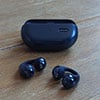From TVs to thermostats, security cameras to baby monitors, the average household now has 21 internet-connected devices, according to a recent report by Netgear and Bitdefender. And a quick check of my home router shows that my household is no different, with phones, laptops, TVs, smart locks, smart bulbs, and our robot vac filling out the list. But as we add more of these Internet of Things (IoT) products to our homes, we may inadvertently be inviting cybercriminals into our most private spaces.

The report reveals some startling facts about the vulnerabilities in our smart homes. Every 24 hours, the average home network faces 10 attacks. While we're sleeping or going about our day, cybercriminals are constantly probing our devices for weaknesses.
What's at stake? More than you might think. A Bitdefender spokesperson told me, "Video and static imagery are the most accessible types of data. In our research, we often spot issues with cloud communication that allow cybercriminals to gain access to storage buckets where video feeds and pictures are stored." This means that those private moments captured by your security cameras or baby monitors could potentially be accessed by unauthorized third parties. It's a chilling thought – strangers peering into your home through the very devices meant to keep you safe.
Read more: Does a Pop-up Mean Your Phone Has Been Hacked?
But the risks don't stop at privacy invasion. "At this point we know that a significant part of IoT traffic is rogue (i.e. caused by compromised devices) and the effects of compromised devices to create massive botnets for launching distributed-denial-of-services attacks (DDoS) as an example can be terrifying," said Bitdefender. Imagine your smart fridge or doorbell being used without your knowledge to take down websites or spread malware.
The most vulnerable devices in your home might surprise you. TVs top the list, accounting for 34% of discovered vulnerabilities, followed by smart plugs at 18%. Why? These devices often go years without updates, functioning well past their support windows.
So, what can you do to protect yourself? There are a few proactive steps you can take.
- Keep your devices updated: Regularly check for and install firmware updates. If there is an option for automatic updates, turn it on.
- Use strong, unique passwords for all your devices and WiFi networks. Use a password manager to keep them safely accessible.
- Consider investing in a router that provides antimalware protection for all devices connected to your home network. These include Netgear routers with Netgear Armor and TP-Link routers with HomeCare, among others.
- Be mindful of what you connect: Ask yourself if that device really needs internet access.
Read more: How to Protect Your Privacy on Public WiFi Networks
A smart home should make your life easier and not expose you to unnecessary risks. By taking proactive steps, you can enjoy the benefits of your smart home devices while resting easy, knowing that they are protecting you, not leaving the door open to digital intruders.
[Image credit: conceptual image of hacker watching security video generated by DALL-E]
For the past 20+ years, Techlicious founder Suzanne Kantra has been exploring and writing about the world’s most exciting and important science and technology issues. Prior to Techlicious, Suzanne was the Technology Editor for Martha Stewart Living Omnimedia and the Senior Technology Editor for Popular Science. Suzanne has been featured on CNN, CBS, and NBC.













